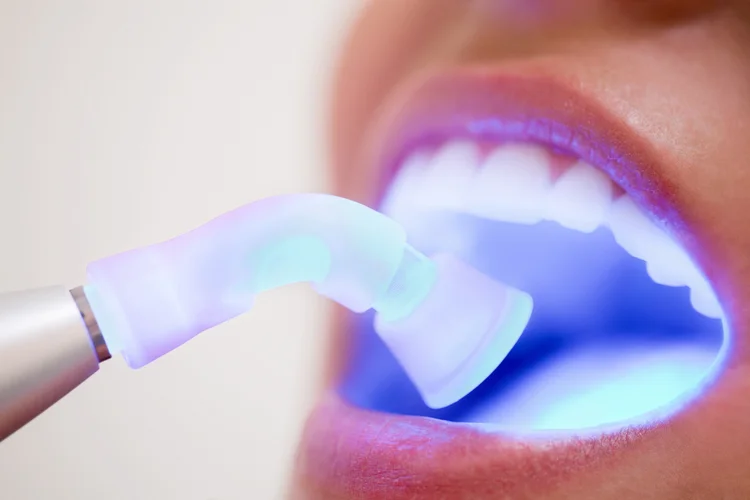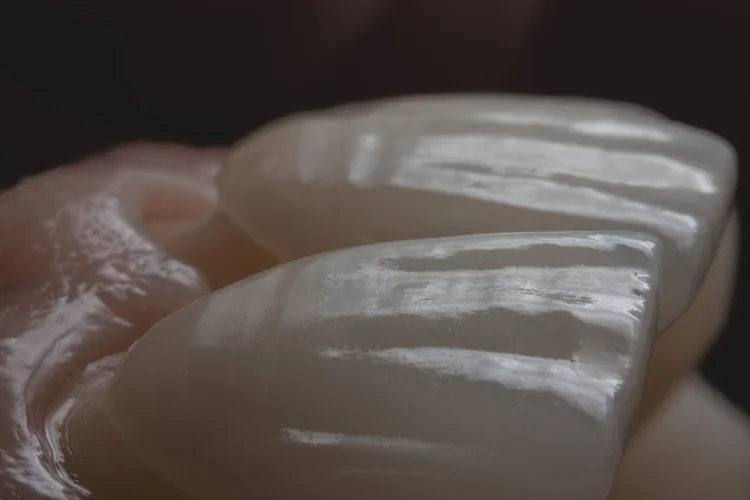If you are thinking about getting veneers, it is important to find the best
match for your smile goals. The two main types of veneers, composite and
porcelain, differ in several key aspects: appearance, durability,
stain resistance, cost, application time, and the amount
of tooth modification required.
In Singapore, veneers have become a popular
option for improving smiles, whether you want to brighten discoloured teeth,
fix minor alignment issues, or restore worn edges. However, not all veneers
are the same. This guide explains the differences between composite and
porcelain veneers, helping you choose the option that best aligns with your
needs, budget, and personal preferences.

WhatsApp Us Now
What Are Porcelain Veneers?
Porcelain veneers are ultra-thin, custom-crafted shells made from durable, dental-grade porcelain. Each veneer is precisely created using detailed impressions of a person’s teeth to replicate the natural translucency and texture of tooth enamel. These veneers are bonded to the front of each tooth with a strong dental adhesive, providing a secure and lasting attachment. Because porcelain is biocompatible and non-porous, it resists stains effectively and delivers a smooth, natural-looking finish.

What Are Composite Veneers?
Composite veneers are made from a tooth-colored resin composite, which is applied directly onto the surface of the tooth and shaped to match its natural form. This process, known as direct bonding, involves layering and sculpting the composite material to fit the tooth’s contours and color. The resin is then hardened using an LED light and polished to give it a smooth, shiny appearance. While it is less translucent than porcelain, composite material can be customized to achieve a natural look and is a flexible choice for cosmetic dental improvements.

Porcelain vs. Composite Veneers: Pros & Cons
Now that we understand each veneer type individually, let’s look at how they stack up against each other:
| Category | Porcelain Veneers | Composite Veneers |
|---|---|---|
| Appearance | Natural, lifelike translucency | Less translucent but still aesthetically pleasing |
| Durability | 10-15 years or more | 5-7 years |
| Stain Resistance | Highly stain-resistant | More prone to staining over time |
| Cost | Higher, premium option | Lower, budget-friendly option |
| Application Time | Multiple dental visits | Usually one dental visit |
| Tooth Alteration | Requires enamel removal | Minimal to no enamel removal |
1. Appearance
Porcelain veneers provide a highly realistic look, thanks to their natural translucency, which closely replicates the depth and sheen of real tooth enamel. This quality helps porcelain veneers blend seamlessly with surrounding teeth, creating an aesthetically pleasing result. Composite veneers, while also attractive, do not possess the same level of translucency as porcelain. However, they can be colour-matched and polished to achieve an appealing and natural-looking finish. Under certain lighting, composite veneers may appear slightly less lifelike, but they remain a practical option that effectively enhances a smile's appearance.
2. Durability
Porcelain veneers are known for their long-term durability, often lasting 10-15 years or more with proper care. Made from strong ceramic, they are highly resistant to chipping and wear, allowing individuals to go about normal activities like eating and drinking. However, caution is advised with hard foods, as they can potentially cause damage. In contrast, composite veneers typically last about 5-7 years and may require periodic touch-ups as the resin material is generally more susceptible to wear and chipping. Nevertheless, they remain a viable option for those seeking a more immediate and affordable enhancement.

3. Stain Resistance
Porcelain veneers are naturally stain-resistant due to their non-porous structure, allowing them to maintain a bright, consistent appearance. This makes them ideal for those concerned about food or beverage staining. Composite veneers, being more porous, are more prone to absorbing pigments from foods, drinks, and lifestyle habits over time. This may lead to some discolouration, often requiring periodic polishing or maintenance to retain their original colour. Despite this, both options can enhance a smile’s appearance when cared for properly.
4. Cost
The premium quality, durability, and lifelike appearance of porcelain veneers come with a higher cost, reflecting their status as a long-term cosmetic investment. The higher initial expense covers the extensive customisation, lab work, and durable material used. Composite veneers, being quicker to apply and made from a less expensive material, are more affordable, presenting a cost-effective solution for those seeking cosmetic improvement.
5. Application Time
Porcelain veneers require a multi-step process for precise customisation, including consultations, tooth contouring, taking detailed impressions, and laboratory fabrication, which necessitates more than one dental visit. In contrast, composite veneers are often applied in a single visit through direct bonding, where the material is layered, shaped, and polished directly onto the tooth. This streamlined approach makes composite veneers an ideal choice for patients seeking a quick, same-day solution.

6. Tooth Alteration
Applying porcelain veneers generally involves removing a thin layer of enamel to ensure a secure and natural fit, making this a permanent alteration to the tooth structure. This enamel reduction is irreversible, meaning that once a porcelain veneer is placed, any future replacement would require another veneer, either porcelain or composite, to cover the prepared surface. Composite veneers, however, typically require little to no enamel removal. This non-invasive approach preserves more of the natural tooth structure, providing a more conservative and less permanent treatment option.
Summary: What Is the Best Type of Veneer for You?
Deciding between composite and porcelain veneers is all about your needs,
budget, and personal preferences. Porcelain veneers offer a natural,
lifelike finish with long-lasting durability and strong stain resistance, making
them ideal for those seeking a premium, low-maintenance solution. Composite veneers,
meanwhile, are a budget-friendly option with minimal tooth preparation and quick,
same-day results, although they may need a bit more maintenance over time.
At True Dental Studio, we offer both composite and porcelain veneers. Ready to
enhance your smile? Schedule
an appointment with our dentist to explore your options and find the perfect
fit for your dental needs.
How Do I Book a Dental Veneers Appointment?
Book Dental Veneers Appointment
Book NowEnquire More Through Email
Email Us NowEnquire More Through WhatsApp
WhatsApp Us NowWhy Choose True Dental Studio?
Friendly Dentist and Team
Our team treats each and every patient to the best of our ability. This is the reason why entire families have continued their dental care with True Dental Studio for many years, from all over Singapore.
Minimal Discomfort
At True Dental, it is our commitment to ensure our patients are kept as comfortable as possible. We aim to minimize discomfort, if any, for our patients.
Affordable Treatments
We believe in pricing quality treatments at a competitive rate. We are transparent and upfront with our treatment costs.
Our Smile Scorecard
Frequently Asked Questions
Both have unique benefits. Porcelain veneers are more durable, stain-resistant, and provide a more natural translucency, making them ideal for long-term results. Composite veneers are less costly, require minimal tooth preparation, and can often be applied in a single visit, though they may need more maintenance over time.
Composite veneers are less durable than porcelain, lasting around 5-7 years and are more prone to staining, chipping, and wear, often needing periodic maintenance. However, they are more affordable and involve minimal tooth preparation, making them a suitable choice for a quicker, budget-friendly solution.
Composite veneers can be a worthwhile choice for those seeking an affordable, less invasive way to enhance their smile. However, they may require more upkeep and are not as long-lasting as porcelain veneers.
The best veneer type depends on individual needs, budget and personal preferences. Porcelain is ideal for longevity, durability, and a lifelike appearance, while composite works well for quick, budget-friendly results with minimal tooth alteration.
Porcelain veneers are known for their natural, lifelike translucency, closely resembling tooth enamel and giving a more realistic appearance compared to composite veneers. However, composite veneers can still be colour-matched for a natural look, offering a more budget-friendly alternative.
After 5 years, composite veneers may begin to show signs of wear, discolouration, or chipping. Touch-ups or replacements are often recommended around this time to maintain their original appearance.
Yes, you can, but it depends on the amount of enamel removed during the procedure. Composite veneers typically require minimal or no enamel removal, allowing the underlying teeth to remain largely intact.
Composite veneers can be damaged by biting hard objects, teeth grinding, acidic foods and drinks, and poor oral hygiene, which may lead to chipping, staining, or premature wear.
Decay can occur if bacteria enter between the veneer and tooth or if oral hygiene is poor. Regular cleanings and good oral care can help prevent decay under composite veneers.
Composite veneers can be replaced multiple times if needed. However, each replacement may subtly impact the tooth structure, so it’s best to consult a dentist for personalised guidance.
Eating with composite veneers generally feels natural, though it’s recommended to avoid very hard or sticky foods, which can chip or dislodge the veneers.
Natural teeth typically remain healthy under composite veneers as long as they are properly cared for with good oral hygiene and regular dental check-ups.
Porcelain veneers often appear more natural due to their translucent quality, closely mimicking real tooth enamel and providing a more aesthetic result. However, composite veneers can still be colour-matched for a pleasing, natural look, making them a budget-friendly alternative.
Many individuals prefer porcelain veneers for their durability, natural appearance, and longevity, making them an ideal choice for achieving a polished, long-lasting smile.
Porcelain veneers are generally more expensive than composite veneers due to their high-quality materials, longer lifespan, and the multiple appointments needed for customisation and application.
